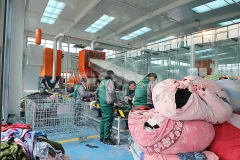
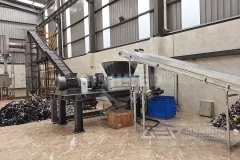
Waste fabrics disposal, similar to tire recycling, is an important aspect of sustainable waste management.Here's an overview of the disposal process:1. Collection and Sorting:Waste fabrics are collected from various sources such as textile manufacturers, garment factories, and post-consumer sources like used clothing and household textiles. These fabrics may include cotton, polyester, nylon, wool, and other materials.2. Shredding:The collected fabrics are shredded into smaller pieces using specialized shredding equipment. Shredding helps to reduce the fabrics into manageable sizes for further processing. 3. Cleaning and Sorting:After shredding, the fabric scraps undergo cleaning to remove any contaminants such as dirt, buttons, zippers, and other non-textile materials. Sorting is also carried out to separate different types of fabrics based on material composition and color.4. Fiber Reclamation:Once cleaned and sorted, the shredded fabric pieces are processed to extract the fibers. This can involve

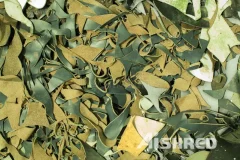
With the rapid development of leather industry, a large number of leather offcuts also caused serious waste of resources and environmental pollution. Especially in the textile, garment, footwear industry is more developed areas, industrial parks pile of leather, cloth offcuts everywhere, bringing serious environmental problems, social problems and government burden. The tannery industry produces a large amount of waste rubber raw materials every year. As a traditional industry with high input and low output, 30% of raw materials in the tanning industry end up as waste in its production process. According to statistics, India discharges about 150,000 tons of tanning waste every year, and the United States has 60,000 tons. And China is a big tanning country, throwing in nearly 200 million pieces of leather every year, which will produce 1.4 million tons of waste. Every year, there are a lot of leather, fabric, shoes, fabric offcuts are casually discarded, which not only causes serious environmental pollution,
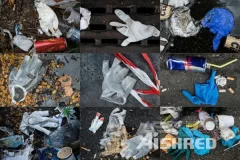
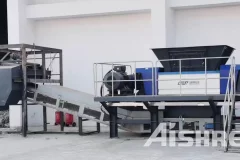
How to Disposal Waste Gloves?
2023-01-31A large number of waste gloves will be produced in industrial production. Some gloves are made of fabric and some are made of rubber. If these waste gloves are directly burned or buried, it will be too wasteful. Waste fabric gloves contain a large amount of fiber and organic matter, which can be used for incineration and power generation after crushing/shredding, and rubber gloves can be used for production of rubber particles after crushing/shredding, which can not only reduce solid waste pollution, but also effectively recycle renewable resources. In the process of recycling waste gloves, shredding is an unavoidable link, which requires a shredder specially developed for waste gloves. The commonly used waste glove shredder is a double-shaft shredder, which processes materials based on the working principle of interaction between cutters. It has good shredding effect on soft and hard materials, and can easily shred a large number of waste gloves. The equipment is designed with low rotational speed and large
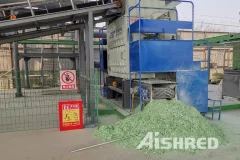
Affordable Single Shaft Shredder for Sale
2022-04-08The GSS series single shaft shredder is the perfect machine for the fine shredding sector: thanks to the trapezoidal blades and the reduced rotation speed, it is able to guarantee excellent performance in terms of energy consumption, production and maintenance. The structure of the machine is made up of very thick electro-welded sheets, such as to guarantee sturdiness and reliability over time. The shredding takes place through the cutting action of the rotating blades on the fixed blades which are mounted on an adjustable crosspiece. A pusher also guarantees the grinding of bulky items, avoiding floating phenomena. The motorization varies according to the requirements of the material to be treated. It is given by a hydraulic motor with relative control unit, keyed to a planetary reduction gear. A screening grid is installed under the rotor. Unlike the shredders already on the market, this machine allows to obtain a ground product with very homogeneous dimensions and defined according to the size of the



